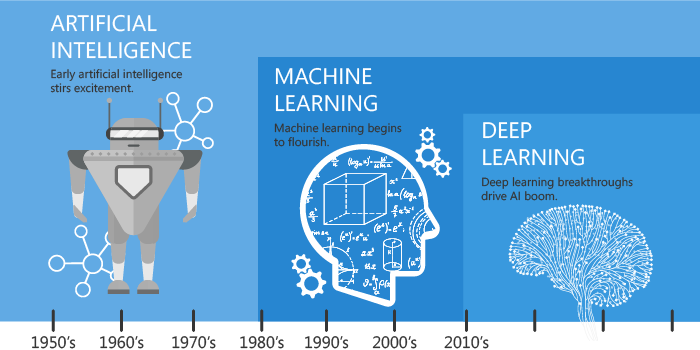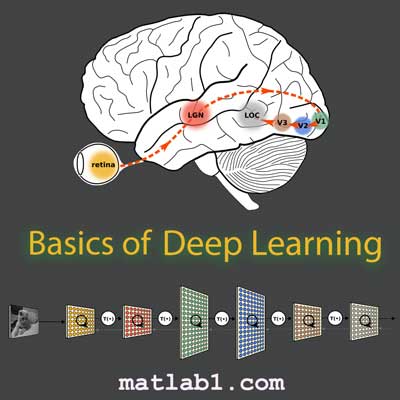Description
This educational video is the third part of the complete course of deep learning in MATLAB.
In this educational video, we will introduce you to the basics of deep learning so that you can gain the necessary knowledge to work in the field of deep learning and be able to implement your models in different programming languages.

Artificial Intelligence machine learning deep learning MATLAB
Artificial intelligence is a simulation of human intelligence. Mankind’s long-held dream of being able to design a system that can function like human intelligence. The human brain, which is the core of decision-making, contains millions of neural neurons that are primarily responsible for intelligence. Every person acquires a huge amount of knowledge and data from their environment during their life. This data is processed by the brain and knowledge is extracted from them. Mathematically expressing the learning function of the brain from the environment is very difficult, so one of the difficulties in modeling intelligence in the brain is the lack of human understanding of the learning function of the brain and its transformation into intelligence. We need to design computer systems that capture the same input as the brain and turn it into intelligence. The key question here is how to turn external data into intelligence so that a computer system can train like our brain and function like our brain.
To solve this problem, the researchers introduced algorithms that extract patterns from the input data. This concept is known as machine learning. With the introduction of machine learning, intelligent systems were able to extract information from the external environment, and models were introduced that to some extent solve the previous problem in artificial intelligence. A simple machine learning algorithm is naïve Bayes that can separate spam emails from real emails.
The efficiency of machine learning algorithms depends on how the input data is expressed. This concept is known as representation. As a system, consider the diagnosis based on machine learning, which performs its diagnostic work based on the results of the patient’s tests such as the amount of sugar, urea, fat, etc. This system itself cannot communicate directly with the patient and can only perform diagnostic work based on the data that the doctor gives to the system. This means that if the doctor does not enter the number of blood lipids, the system cannot respond because it is one of the unknown inputs. This system can not work on the basis of the MRI image because it can not have a correct understanding of the image and only makes decisions based on the patient’s test data.
Many AI tasks can be solved by designing features to extract data from input with the help of machine learning algorithms. For example, one of the features used to identify the speaker in speech signal processing is estimating the size of the speaker’s vocal tract. An algorithm with this feature can detect whether the speaker is male, female, or child.
The important point here is that we do not know what features to extract in each user to achieve the best efficiency, so feature extraction is one of the weaknesses of machine learning models. Sometimes finding the right features for a particular application is found after realizing hundreds of researchers, which indicates the weakness of machine learning models.
Deep learning was proposed to solve the problem of machine learning models. Deep learning models no longer followed feature extraction algorithms and could function like the human brain with the help of their layers. You can see a conceptual form of deep learning in the following figure, which is well explained in the educational video of the basics of deep learning in MATLAB :

Basics of deep learning MATLAB
Headlines :
human brain
Neurons in the human brain
Why deep learning?
History of artificial intelligence and deep learning
The first artificial neural network
An overview of artificial intelligence and human competitions
Today’s applications of artificial intelligence
Example of a driverless car
Milestones in AI
Statistics of the number of articles in the field of deep learning
Introducing TensorFlow, Pytorch and Keras libraries
Relationship between Keras and TensorFlow
Introducing CPU, GPU and TPU
Deep learning programming for mobile
Deep learning programming for the cloud
Farewell to Python 2
The Importance of Python 3
What is machine learning?
How to implement machine learning?
The importance of data in deep learning
Why do we have to learn deep learning now?
Recent advances in deep learning
Deep learning in medicine
Diagnosis of genetic disease from a person’s face
Various applications of deep learning
The connection between artificial intelligence and machine learning and deep learning
The difference between machine learning and deep learning
The concept of deep learning
(Edge, corners, and parts of the object) In the visual machine with deep learning
A step-by-step explanation of a deep learning model
Interpret the output of a deep learning system
Why does a deep learning system output as a percentage of probability?
The concept of representation in deep learning
Increase data dimension
Relationship between efficiency and volume of training data in deep learning and machine learning
The role of data in deep learning
The disadvantage of deep learning
How much data is needed for a deep learning system?
A practical example from GitHub
Why is so much data needed in deep learning?
Despite its weakness in deep learning, why is it still so widely used?
Difficulties in deep learning
Inter class variation
Data argumentation
A practical example of deep learning
Types of learning
Learn with the observer
Pseudo-learning with the observer
Learning without an observer
Patterning of human learning
An example of amplified learning in driverless cars
Cut data
Data reflection
Resize data
Rotate the data
Data transfer
Noise in data
Challenges in deep learning
Training and testing
The concept of regression
The concept of classification
The concept of Multi-Class
Multi-Label Concept
What can we do with deep learning?
Deep concept
Hidden layer
Neural networks and deep learning
The concept of overfitting
Impact of data number on overfitting
How do we know if overfitting is happening?
Concept of Regularization
Validation data and training data
Use Dropout
Normalization
Batch normalization
Batch Renormalization
What is the purpose of normalization?
What is the meaning of batch?
What is the effect of batch normalization on deep learning?
Introducing famous deep learning networks
Introducing the AlexNet network
Introducing VGG-16 network
Introducing GoogleNet
Change predefined networks
An important point in using pre-trained deep learning networks
The evolution of deep learning networks
Can a deep learning model do the job of recognition better than humans?
Comparing the efficiency of Alexnet, GoogleNet, ZFNet, VGGNet, RESNet, GoogleNet v4 and SENet networks
object detection
Positioning objects
What is the heart of deep learning?
The concept of Transfer Learning
Generative Adversarial Network (GAN)
Advantage of GAN network
GAN network structure
Generator and Discriminator function
Introduction to AutoML machine learning
Deep learning network design automatically
Search for the best structure for deep learning
Introducing Reinforcement Learning
The concept of Agent and Environment
Depth measurement in deep learning models
RNN return networks
Advantages and disadvantages of RNN network


Reviews
There are no reviews yet.